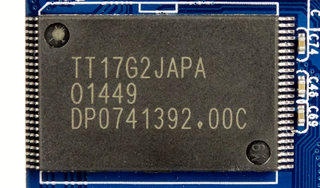Phison S10: Toshiba MLC And TLC Versus Micron L95B MLC
Phison offered to let us test its S10 controller with three flash types that will ship in 2015: Toshiba's A19 TLC, 15nm MLC and Micron L95B 16nm MLC.
A Closer Look


All nine of the drives we're testing use Phison's PS3110-S10 controller and Nanya DRAM. The DRAM buffer is the same size at each capacity point, but grows as you step up through the drives equipped with more NAND. After all, larger SSDs require more DRAM to cache the page table map.

The most interesting flash we're testing is Toshiba's A19 TLC. OCZ recently released its Trion 100 family with this stuff, but that's the only retail product so far with it. All of the A19 TLC flash we've seen so far has been in TSOP packages (the silver connection points on the side of the package).

The three A19 TLC drives use 16 NAND flash packages to increase parallelism. The six MLC drives use just eight packages.

The Toshiba 15nm MLC is in BGA packages, with eight on each PCB. Toshiba 15nm MLC is still very rare. At this time, no retail products use this flash, though we expect it to ship in a number of SSDs before the end of the year. This is the most advanced 2D NAND flash process available, allowing Flash Forward (Toshiba and SanDisk's joint venture) to pack more dies per wafer than any other.

Micron's L95B (16nm MLC) is in a number of products. Crucial's MX100 was one of the first SSDs to use it.
At Computex 2015, Micron announced 16nm TLC flash, but we don't think it will appear in retail products until early 2016. Micron's 16nm TLC retains the same 128Gb density per die, though the die is 28% smaller than L95B.
Stay on the Cutting Edge
Join the experts who read Tom's Hardware for the inside track on enthusiast PC tech news — and have for over 25 years. We'll send breaking news and in-depth reviews of CPUs, GPUs, AI, maker hardware and more straight to your inbox.
-
James Mason Replywhoa, where did you guys get some 4800GB just for the battery life tests?
Yeah so many typos I almost thought they actually did get 5 terabyte SSDs somehow.
-
Frozen Fractal I was arranging a chart while reading this article to see who actually wins. Seems like Toshiba 15nm MLC wins the test, with Micron 16nm MLC close on tail and TLCs wayyyy off :D.Reply
It is kinda disappointing to see TLCs being outperformed so brutally. I guess increased SLC buffer should mitigate the problem? Samsung already has like this in the EVO 2TB so what do you think Chris?
Also, does lithography has anything to do with performance? I mean Micron's NANDs are close to Toshiba's MLCs and Micron's cells are just 1nm bigger than Toshiba's MLCs. Can this be co-related somehow? -
WyomingKnott It is so cool that they provided these for a head-to-head comparison. Finally, a comparison with all other variables really held even.Reply
Most Popular


